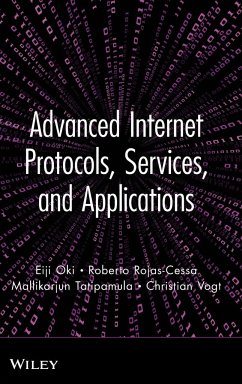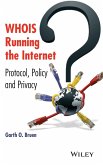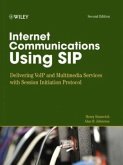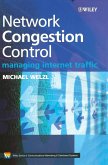Eiji Oki, Roberto Rojas-Cessa, Mallikarjun Tatipamula, Christian Vogt
Advanced Internet Protocols
By Oki, Eiji; Rojas-Cessa, Roberto; Tatipamula, Mallikarjun; Vogt, Christian
Schade – dieser Artikel ist leider ausverkauft. Sobald wir wissen, ob und wann der Artikel wieder verfügbar ist, informieren wir Sie an dieser Stelle.
Eiji Oki, Roberto Rojas-Cessa, Mallikarjun Tatipamula, Christian Vogt
Advanced Internet Protocols
By Oki, Eiji; Rojas-Cessa, Roberto; Tatipamula, Mallikarjun; Vogt, Christian
- Gebundenes Buch
- Merkliste
- Auf die Merkliste
- Bewerten Bewerten
- Teilen
- Produkt teilen
- Produkterinnerung
- Produkterinnerung
Today, the internet and computer networking are essential parts of business, learning, and personal communications and entertainment. Virtually all messages or transactions sent over the internet are carried using internet infrastructure- based on advanced internet protocols. Advanced internet protocols ensure that both public and private networks operate with maximum performance, security, and flexibility.
This book is intended to provide a comprehensive technical overview and survey of advanced internet protocols, first providing a solid introduction and going on to discuss…mehr
Andere Kunden interessierten sich auch für
![Whois Running the Internet Whois Running the Internet]() Garth O. BruenWhois Running the Internet107,99 €
Garth O. BruenWhois Running the Internet107,99 €![Cloud Computing Cloud Computing]() Eric BauerCloud Computing96,99 €
Eric BauerCloud Computing96,99 €![Internet Communications Using Sip Internet Communications Using Sip]() Henry SinnreichInternet Communications Using Sip88,99 €
Henry SinnreichInternet Communications Using Sip88,99 €![Intelligent Internet Knowledge Networks Intelligent Internet Knowledge Networks]() Syed V. AhamedIntelligent Internet Knowledge Networks176,99 €
Syed V. AhamedIntelligent Internet Knowledge Networks176,99 €![Network Congestion Control Network Congestion Control]() Michael WelzlNetwork Congestion Control134,99 €
Michael WelzlNetwork Congestion Control134,99 €![Multimedia Engineering Multimedia Engineering]() A. C. M. FongMultimedia Engineering96,99 €
A. C. M. FongMultimedia Engineering96,99 €![The Semantic Web The Semantic Web]() Bo LeufThe Semantic Web114,99 €
Bo LeufThe Semantic Web114,99 €-
-
-
Today, the internet and computer networking are essential parts of business, learning, and personal communications and entertainment. Virtually all messages or transactions sent over the internet are carried using internet infrastructure- based on advanced internet protocols. Advanced internet protocols ensure that both public and private networks operate with maximum performance, security, and flexibility.
This book is intended to provide a comprehensive technical overview and survey of advanced internet protocols, first providing a solid introduction and going on to discuss internetworking technologies, architectures and protocols. The book also shows application of the concepts in next generation networks and discusses protection and restoration, as well as various tunnelling protocols and applications. The book ends with a thorough discussion of emerging topics.
This book is intended to provide a comprehensive technical overview and survey of advanced internet protocols, first providing a solid introduction and going on to discuss internetworking technologies, architectures and protocols. The book also shows application of the concepts in next generation networks and discusses protection and restoration, as well as various tunnelling protocols and applications. The book ends with a thorough discussion of emerging topics.
Produktdetails
- Produktdetails
- Verlag: Wiley & Sons
- 1. Auflage
- Seitenzahl: 260
- Erscheinungstermin: 24. April 2012
- Englisch
- Abmessung: 240mm x 161mm x 19mm
- Gewicht: 508g
- ISBN-13: 9780470499030
- ISBN-10: 0470499036
- Artikelnr.: 32567668
- Herstellerkennzeichnung
- Libri GmbH
- Europaallee 1
- 36244 Bad Hersfeld
- gpsr@libri.de
- Verlag: Wiley & Sons
- 1. Auflage
- Seitenzahl: 260
- Erscheinungstermin: 24. April 2012
- Englisch
- Abmessung: 240mm x 161mm x 19mm
- Gewicht: 508g
- ISBN-13: 9780470499030
- ISBN-10: 0470499036
- Artikelnr.: 32567668
- Herstellerkennzeichnung
- Libri GmbH
- Europaallee 1
- 36244 Bad Hersfeld
- gpsr@libri.de
EIJI OKI, PHD, is an Associate Professor at the University of Electro-Communications in Tokyo and was the recipient of the IEEE's 2001 Asia-Pacific Outstanding Young Researcher Award. ROBERTO ROJAS-CESSA, PHD, is an Associate Professor in the Department of Electrical and Computer Engineering at New Jersey Institute of Technology. MALLIKARJUN TATIPAMULA, PHD, is Head of Packet Technologies Research at Ericsson Silicon Valley. He has over twenty years of experience in the telecommunications/networking industry, with more than 100 published papers and patents. CHRISTIAN VOGT is a Senior Marketing Manager at Ericsson Silicon Valley.
Preface xi
Acknowledgments xv
About the Authors xvii
1 Transmission Control Protocol/Internet Protocol Overview 1
1.1 Fundamental Architecture / 1
1.2 Internet Protocol Basics / 4
1.2.1 Packet Header / 5
1.2.2 Internet Protocol Address / 7
1.2.3 Internet Protocol Classification / 7
1.2.4 Subnet and its Masking / 9
1.2.5 Subnet Calculation / 11
1.3 Routing / 13
1.3.1 Routing across Providers / 14
1.3.2 Routing within Edge Networks / 15
1.3.3 Routing Scalability / 16
References / 18
2 Transport-Layer Protocols 19
2.1 Transmission Control Protocol / 19
2.1.1 Transmission Control Protocol Header Structure / 19
2.1.2 Three-Way Handshake / 20
2.1.3 Transmission Control Protocol Flow Control and Congestion Control /
21
2.1.4 Port Number / 24
2.2 User Datagram Protocol / 25
2.2.1 User Datagram Protocol Header Structure / 25
2.3 Stream Control Transmission Protocol / 26
2.3.1 Stream Control Transmission Protocol Packet Structure / 26
2.3.2 Security: Prevention of SYN Attacks / 27
2.4 Real-Time Transport Protocol / 29
2.4.1 Real-Time Transport Protocol Header Structure / 29
References / 30
3 Internet Architecture 31
3.1 Internet Exchange Point / 31
3.2 History of Internet Exchange Points / 33
3.3 Internet Service Provider Interconnection Relationships / 34
3.4 Peering and Transit / 35
References / 37
4 IP Routing Protocols 39
4.1 Overview of Routing Protocols / 40
4.1.1 Interior Gateway Protocol / 41
4.1.2 Exterior Gateway Protocol / 42
4.2 Routing Information Protocol / 43
4.2.1 Routing Information Protocol Header Format / 43
4.2.2 Update of Routing Table in Routing Information Protocol / 44
4.2.3 Maintenance of Routing Table in Routing Information Protocol / 46
4.2.4 Split Horizon / 47
4.2.5 Limitations of Routing Information Protocol / 47
4.3 Open Shortest Path First / 48
4.3.1 Shortest-Path Algorithm / 48
4.3.2 Hierarchical Routing / 51
4.3.3 Open Shortest Path First Packet Format / 51
4.3.4 Comparison of Routing Information Protocol and Open Shortest Path
First / 52
4.4 Border Gateway Protocol / 53
4.4.1 Border Gateway Protocol Message Flows / 53
4.4.2 Border Gateway Protocol Policy Selection Attributes / 54
References / 57
5 Multiprotocol Label Switching 59
5.1 Overview / 59
5.2 Functions and Mechanisms / 63
5.3 Applicabilities / 67
References / 72
6 IP Quality Of Service 75
6.1 Introduction / 75
6.2 Quality of Service in IP Version 4 / 75
6.3 Integrated Services / 77
6.3.1 Packet Scheduler / 77
6.3.2 Packet Classifier / 77
6.3.3 Admission Control / 78
6.3.4 Resource Reservation Protocol (RSVP) / 79
6.4 Differentiated Services / 81
6.5 Quality Of Service with Nested Differentiated Services Levels / 82
6.5.1 Drawbacks of Explicit Endpoint Admission Control with Path Selection
/ 84
6.5.2 OSPF-Based Adaptive and Flexible Quality of Service Provisioning / 85
6.5.3 Combination of Security and Quality of Service / 86
6.5.4 Path Selection Algorithm Analysis / 87
References / 90
7 IP Multicast and Anycast 93
7.1 Addressing / 93
7.1.1 Multicast Addressing / 93
7.1.2 Differences between Multicasting and Multiple Unicasting / 95
7.2 Multicast Routing / 96
7.2.1 Optimal Routing: Shortest-Path Trees / 96
7.2.2 Unicast Routing / 96
7.2.3 Multicast Routing / 96
7.3 Routing Protocols / 97
7.3.1 Multicast Open Shortest Path First (MOSPF) / 98
7.3.2 Distance Vector Multicast Routing Protocol / 99
7.3.3 Core-Based Tree (CBT) Protocol / 100
7.3.4 Protocol-Independent Multicast / 101
7.3.5 Simple Multicast Routing Protocol / 101
7.4 Anycasting / 102
7.4.1 Architectural Issues / 103
7.4.2 Anycast Addresses / 103
7.4.3 Differences between the Services Offered by IP Multicasting and IP
Anycasting / 104
7.5 IPv6 Anycast Routing Protocol: Protocol-Independent Anycast-Sparse Mode
/ 105
References / 106
8 Layer-2 Transport over Packet 109
8.1 Draft-Martini Signaling and Encapsulation / 109
8.1.1 Functionality / 110
8.1.2 Encapsulation / 110
8.1.3 Protocol-Specific Encapsulation / 111
8.2 Layer-2 Tunneling Protocol / 114
8.2.1 Layer-2 Tunneling Protocol Version 3 / 115
8.2.2 Pseudowire Emulation Edge to Edge / 118
References / 121
9 Virtual Private Wired Service 123
9.1 Types of Private Wire Services / 123
9.1.1 Layer-2 Virtual Private Services: Wide Area Networks and Local Area
Networks / 124
9.1.2 Virtual Private Wire Service / 126
9.1.3 Virtual Private Multicast Service / 127
9.1.4 IP-Only Layer-2 Virtual Private Network / 128
9.1.5 Internet Protocol Security / 129
9.2 Generic Routing Encapsulation / 130
9.3 Layer-2 Tunneling Protocol / 131
9.4 Layer-3 Virtual Private Network 2547bis, Virtual Router / 131
9.4.1 Virtual Router Redundancy Protocol / 133
References / 136
10 IP and Optical Networking 137
10.1 IP/Optical Network Evolution / 138
10.1.1 Where Networking Is Today / 138
10.1.2 Where Networking Is Going / 139
10.2 Challenges in Legacy Traditional IP/Optical Networks / 140
10.2.1 Proprietary Network Management Systems / 140
10.2.2 Complexity of Provisioning in Legacy IP/Optical Networks / 141
10.3 Automated Provisioning in IP/Optical Networks / 142
10.4 Control Plane Models for IP/Optical Networking / 144
10.4.1 Optical Internetworking Forum's Optical User Network Interface:
Overlay Model / 145
10.4.2 Internet EngineeringTask Force's Generalized Multiprotocol Label
Switching: Peer Model / 145
10.5 Next-Generation MultiLayer Network Design Requirements / 147
10.6 Benefits and Challenges in IP/Optical Networking / 148
References / 149
11 IP Version 6 151
11.1 Addresses in IP Version 6 / 152
11.1.1 Unicast IP Addresses / 152
11.1.2 Multicast IP Addresses / 153
11.2 IP Packet Headers / 154
11.3 IP Address Resolution / 155
11.4 IP Version 6 Deployment: Drivers and Impediments / 156
11.4.1 Need for Backwards Compatibility / 157
11.4.2 Initial Deployment Drivers / 158
11.4.3 Reaching a Critical Mass / 160
References / 161
12 IP Traffic Engineering 163
12.1 Models of Traffic Demands / 163
12.2 Optimal Routing with Multiprotocol Label Switching / 165
12.2.1 Overview / 165
12.2.2 Applicability of Optimal Routing / 165
12.2.3 Network Model / 166
12.2.4 Optimal Routing Formulations with Three Models / 166
12.3 Link-Weight Optimization with Open Shortest Path First / 169
12.3.1 Overview / 169
12.3.2 Examples of Routing Control with Link Weights / 170
12.3.3 Link-Weight Setting Against Network Failure / 172
12.4 Extended Shortest-Path-Based Routing Schemes / 173
12.4.1 Smart-Open Shortest Path First / 174
12.4.2 Two-Phase Routing / 174
12.4.3 Fine Two-Phase Routing / 176
12.4.4 Features of Routing Schemes / 177
References / 177
13 IP Network Security 181
13.1 Introduction / 181
13.2 Detection of Denial-of-Service Attack / 182
13.2.1 Backscatter Analysis / 182
13.2.2 Multilevel Tree or Online Packet Statistics / 184
13.3 IP Traceback / 187
13.3.1 IP Traceback Solutions / 189
13.4 Edge Sampling Scheme / 189
13.5 Advanced Marking Scheme / 193
References / 196
14 Mobility Support for IP 197
14.1 Mobility Management Approaches / 199
14.1.1 Host Routes / 200
14.1.2 Tunneling / 201
14.1.3 Route Optimization / 203
14.2 Security Threats Related to IP Mobility / 205
14.2.1 Impersonation / 205
14.2.2 Redirection-Based Flooding / 208
14.2.3 Possible Solutions / 210
14.3 Mobility Support in IPv6 / 213
14.4 Reactive Versus Proactive Mobility Support / 218
14.5 Relation to Multihoming / 219
14.6 Protocols Supplementing Mobility / 220
14.6.1 Router and Subnet Prefix Discovery / 220
14.6.2 Movement Detection / 221
14.6.3 IP Address Configuration / 222
14.6.4 Neighbor Unreachability Detection / 223
14.6.5 Internet Control Message Protocol for IP Version 6 / 224
14.6.6 Optimizations / 224
14.6.7 Media-Independent Handover Services / 227
References / 231
Index 235
Acknowledgments xv
About the Authors xvii
1 Transmission Control Protocol/Internet Protocol Overview 1
1.1 Fundamental Architecture / 1
1.2 Internet Protocol Basics / 4
1.2.1 Packet Header / 5
1.2.2 Internet Protocol Address / 7
1.2.3 Internet Protocol Classification / 7
1.2.4 Subnet and its Masking / 9
1.2.5 Subnet Calculation / 11
1.3 Routing / 13
1.3.1 Routing across Providers / 14
1.3.2 Routing within Edge Networks / 15
1.3.3 Routing Scalability / 16
References / 18
2 Transport-Layer Protocols 19
2.1 Transmission Control Protocol / 19
2.1.1 Transmission Control Protocol Header Structure / 19
2.1.2 Three-Way Handshake / 20
2.1.3 Transmission Control Protocol Flow Control and Congestion Control /
21
2.1.4 Port Number / 24
2.2 User Datagram Protocol / 25
2.2.1 User Datagram Protocol Header Structure / 25
2.3 Stream Control Transmission Protocol / 26
2.3.1 Stream Control Transmission Protocol Packet Structure / 26
2.3.2 Security: Prevention of SYN Attacks / 27
2.4 Real-Time Transport Protocol / 29
2.4.1 Real-Time Transport Protocol Header Structure / 29
References / 30
3 Internet Architecture 31
3.1 Internet Exchange Point / 31
3.2 History of Internet Exchange Points / 33
3.3 Internet Service Provider Interconnection Relationships / 34
3.4 Peering and Transit / 35
References / 37
4 IP Routing Protocols 39
4.1 Overview of Routing Protocols / 40
4.1.1 Interior Gateway Protocol / 41
4.1.2 Exterior Gateway Protocol / 42
4.2 Routing Information Protocol / 43
4.2.1 Routing Information Protocol Header Format / 43
4.2.2 Update of Routing Table in Routing Information Protocol / 44
4.2.3 Maintenance of Routing Table in Routing Information Protocol / 46
4.2.4 Split Horizon / 47
4.2.5 Limitations of Routing Information Protocol / 47
4.3 Open Shortest Path First / 48
4.3.1 Shortest-Path Algorithm / 48
4.3.2 Hierarchical Routing / 51
4.3.3 Open Shortest Path First Packet Format / 51
4.3.4 Comparison of Routing Information Protocol and Open Shortest Path
First / 52
4.4 Border Gateway Protocol / 53
4.4.1 Border Gateway Protocol Message Flows / 53
4.4.2 Border Gateway Protocol Policy Selection Attributes / 54
References / 57
5 Multiprotocol Label Switching 59
5.1 Overview / 59
5.2 Functions and Mechanisms / 63
5.3 Applicabilities / 67
References / 72
6 IP Quality Of Service 75
6.1 Introduction / 75
6.2 Quality of Service in IP Version 4 / 75
6.3 Integrated Services / 77
6.3.1 Packet Scheduler / 77
6.3.2 Packet Classifier / 77
6.3.3 Admission Control / 78
6.3.4 Resource Reservation Protocol (RSVP) / 79
6.4 Differentiated Services / 81
6.5 Quality Of Service with Nested Differentiated Services Levels / 82
6.5.1 Drawbacks of Explicit Endpoint Admission Control with Path Selection
/ 84
6.5.2 OSPF-Based Adaptive and Flexible Quality of Service Provisioning / 85
6.5.3 Combination of Security and Quality of Service / 86
6.5.4 Path Selection Algorithm Analysis / 87
References / 90
7 IP Multicast and Anycast 93
7.1 Addressing / 93
7.1.1 Multicast Addressing / 93
7.1.2 Differences between Multicasting and Multiple Unicasting / 95
7.2 Multicast Routing / 96
7.2.1 Optimal Routing: Shortest-Path Trees / 96
7.2.2 Unicast Routing / 96
7.2.3 Multicast Routing / 96
7.3 Routing Protocols / 97
7.3.1 Multicast Open Shortest Path First (MOSPF) / 98
7.3.2 Distance Vector Multicast Routing Protocol / 99
7.3.3 Core-Based Tree (CBT) Protocol / 100
7.3.4 Protocol-Independent Multicast / 101
7.3.5 Simple Multicast Routing Protocol / 101
7.4 Anycasting / 102
7.4.1 Architectural Issues / 103
7.4.2 Anycast Addresses / 103
7.4.3 Differences between the Services Offered by IP Multicasting and IP
Anycasting / 104
7.5 IPv6 Anycast Routing Protocol: Protocol-Independent Anycast-Sparse Mode
/ 105
References / 106
8 Layer-2 Transport over Packet 109
8.1 Draft-Martini Signaling and Encapsulation / 109
8.1.1 Functionality / 110
8.1.2 Encapsulation / 110
8.1.3 Protocol-Specific Encapsulation / 111
8.2 Layer-2 Tunneling Protocol / 114
8.2.1 Layer-2 Tunneling Protocol Version 3 / 115
8.2.2 Pseudowire Emulation Edge to Edge / 118
References / 121
9 Virtual Private Wired Service 123
9.1 Types of Private Wire Services / 123
9.1.1 Layer-2 Virtual Private Services: Wide Area Networks and Local Area
Networks / 124
9.1.2 Virtual Private Wire Service / 126
9.1.3 Virtual Private Multicast Service / 127
9.1.4 IP-Only Layer-2 Virtual Private Network / 128
9.1.5 Internet Protocol Security / 129
9.2 Generic Routing Encapsulation / 130
9.3 Layer-2 Tunneling Protocol / 131
9.4 Layer-3 Virtual Private Network 2547bis, Virtual Router / 131
9.4.1 Virtual Router Redundancy Protocol / 133
References / 136
10 IP and Optical Networking 137
10.1 IP/Optical Network Evolution / 138
10.1.1 Where Networking Is Today / 138
10.1.2 Where Networking Is Going / 139
10.2 Challenges in Legacy Traditional IP/Optical Networks / 140
10.2.1 Proprietary Network Management Systems / 140
10.2.2 Complexity of Provisioning in Legacy IP/Optical Networks / 141
10.3 Automated Provisioning in IP/Optical Networks / 142
10.4 Control Plane Models for IP/Optical Networking / 144
10.4.1 Optical Internetworking Forum's Optical User Network Interface:
Overlay Model / 145
10.4.2 Internet EngineeringTask Force's Generalized Multiprotocol Label
Switching: Peer Model / 145
10.5 Next-Generation MultiLayer Network Design Requirements / 147
10.6 Benefits and Challenges in IP/Optical Networking / 148
References / 149
11 IP Version 6 151
11.1 Addresses in IP Version 6 / 152
11.1.1 Unicast IP Addresses / 152
11.1.2 Multicast IP Addresses / 153
11.2 IP Packet Headers / 154
11.3 IP Address Resolution / 155
11.4 IP Version 6 Deployment: Drivers and Impediments / 156
11.4.1 Need for Backwards Compatibility / 157
11.4.2 Initial Deployment Drivers / 158
11.4.3 Reaching a Critical Mass / 160
References / 161
12 IP Traffic Engineering 163
12.1 Models of Traffic Demands / 163
12.2 Optimal Routing with Multiprotocol Label Switching / 165
12.2.1 Overview / 165
12.2.2 Applicability of Optimal Routing / 165
12.2.3 Network Model / 166
12.2.4 Optimal Routing Formulations with Three Models / 166
12.3 Link-Weight Optimization with Open Shortest Path First / 169
12.3.1 Overview / 169
12.3.2 Examples of Routing Control with Link Weights / 170
12.3.3 Link-Weight Setting Against Network Failure / 172
12.4 Extended Shortest-Path-Based Routing Schemes / 173
12.4.1 Smart-Open Shortest Path First / 174
12.4.2 Two-Phase Routing / 174
12.4.3 Fine Two-Phase Routing / 176
12.4.4 Features of Routing Schemes / 177
References / 177
13 IP Network Security 181
13.1 Introduction / 181
13.2 Detection of Denial-of-Service Attack / 182
13.2.1 Backscatter Analysis / 182
13.2.2 Multilevel Tree or Online Packet Statistics / 184
13.3 IP Traceback / 187
13.3.1 IP Traceback Solutions / 189
13.4 Edge Sampling Scheme / 189
13.5 Advanced Marking Scheme / 193
References / 196
14 Mobility Support for IP 197
14.1 Mobility Management Approaches / 199
14.1.1 Host Routes / 200
14.1.2 Tunneling / 201
14.1.3 Route Optimization / 203
14.2 Security Threats Related to IP Mobility / 205
14.2.1 Impersonation / 205
14.2.2 Redirection-Based Flooding / 208
14.2.3 Possible Solutions / 210
14.3 Mobility Support in IPv6 / 213
14.4 Reactive Versus Proactive Mobility Support / 218
14.5 Relation to Multihoming / 219
14.6 Protocols Supplementing Mobility / 220
14.6.1 Router and Subnet Prefix Discovery / 220
14.6.2 Movement Detection / 221
14.6.3 IP Address Configuration / 222
14.6.4 Neighbor Unreachability Detection / 223
14.6.5 Internet Control Message Protocol for IP Version 6 / 224
14.6.6 Optimizations / 224
14.6.7 Media-Independent Handover Services / 227
References / 231
Index 235
Preface xi
Acknowledgments xv
About the Authors xvii
1 Transmission Control Protocol/Internet Protocol Overview 1
1.1 Fundamental Architecture / 1
1.2 Internet Protocol Basics / 4
1.2.1 Packet Header / 5
1.2.2 Internet Protocol Address / 7
1.2.3 Internet Protocol Classification / 7
1.2.4 Subnet and its Masking / 9
1.2.5 Subnet Calculation / 11
1.3 Routing / 13
1.3.1 Routing across Providers / 14
1.3.2 Routing within Edge Networks / 15
1.3.3 Routing Scalability / 16
References / 18
2 Transport-Layer Protocols 19
2.1 Transmission Control Protocol / 19
2.1.1 Transmission Control Protocol Header Structure / 19
2.1.2 Three-Way Handshake / 20
2.1.3 Transmission Control Protocol Flow Control and Congestion Control /
21
2.1.4 Port Number / 24
2.2 User Datagram Protocol / 25
2.2.1 User Datagram Protocol Header Structure / 25
2.3 Stream Control Transmission Protocol / 26
2.3.1 Stream Control Transmission Protocol Packet Structure / 26
2.3.2 Security: Prevention of SYN Attacks / 27
2.4 Real-Time Transport Protocol / 29
2.4.1 Real-Time Transport Protocol Header Structure / 29
References / 30
3 Internet Architecture 31
3.1 Internet Exchange Point / 31
3.2 History of Internet Exchange Points / 33
3.3 Internet Service Provider Interconnection Relationships / 34
3.4 Peering and Transit / 35
References / 37
4 IP Routing Protocols 39
4.1 Overview of Routing Protocols / 40
4.1.1 Interior Gateway Protocol / 41
4.1.2 Exterior Gateway Protocol / 42
4.2 Routing Information Protocol / 43
4.2.1 Routing Information Protocol Header Format / 43
4.2.2 Update of Routing Table in Routing Information Protocol / 44
4.2.3 Maintenance of Routing Table in Routing Information Protocol / 46
4.2.4 Split Horizon / 47
4.2.5 Limitations of Routing Information Protocol / 47
4.3 Open Shortest Path First / 48
4.3.1 Shortest-Path Algorithm / 48
4.3.2 Hierarchical Routing / 51
4.3.3 Open Shortest Path First Packet Format / 51
4.3.4 Comparison of Routing Information Protocol and Open Shortest Path
First / 52
4.4 Border Gateway Protocol / 53
4.4.1 Border Gateway Protocol Message Flows / 53
4.4.2 Border Gateway Protocol Policy Selection Attributes / 54
References / 57
5 Multiprotocol Label Switching 59
5.1 Overview / 59
5.2 Functions and Mechanisms / 63
5.3 Applicabilities / 67
References / 72
6 IP Quality Of Service 75
6.1 Introduction / 75
6.2 Quality of Service in IP Version 4 / 75
6.3 Integrated Services / 77
6.3.1 Packet Scheduler / 77
6.3.2 Packet Classifier / 77
6.3.3 Admission Control / 78
6.3.4 Resource Reservation Protocol (RSVP) / 79
6.4 Differentiated Services / 81
6.5 Quality Of Service with Nested Differentiated Services Levels / 82
6.5.1 Drawbacks of Explicit Endpoint Admission Control with Path Selection
/ 84
6.5.2 OSPF-Based Adaptive and Flexible Quality of Service Provisioning / 85
6.5.3 Combination of Security and Quality of Service / 86
6.5.4 Path Selection Algorithm Analysis / 87
References / 90
7 IP Multicast and Anycast 93
7.1 Addressing / 93
7.1.1 Multicast Addressing / 93
7.1.2 Differences between Multicasting and Multiple Unicasting / 95
7.2 Multicast Routing / 96
7.2.1 Optimal Routing: Shortest-Path Trees / 96
7.2.2 Unicast Routing / 96
7.2.3 Multicast Routing / 96
7.3 Routing Protocols / 97
7.3.1 Multicast Open Shortest Path First (MOSPF) / 98
7.3.2 Distance Vector Multicast Routing Protocol / 99
7.3.3 Core-Based Tree (CBT) Protocol / 100
7.3.4 Protocol-Independent Multicast / 101
7.3.5 Simple Multicast Routing Protocol / 101
7.4 Anycasting / 102
7.4.1 Architectural Issues / 103
7.4.2 Anycast Addresses / 103
7.4.3 Differences between the Services Offered by IP Multicasting and IP
Anycasting / 104
7.5 IPv6 Anycast Routing Protocol: Protocol-Independent Anycast-Sparse Mode
/ 105
References / 106
8 Layer-2 Transport over Packet 109
8.1 Draft-Martini Signaling and Encapsulation / 109
8.1.1 Functionality / 110
8.1.2 Encapsulation / 110
8.1.3 Protocol-Specific Encapsulation / 111
8.2 Layer-2 Tunneling Protocol / 114
8.2.1 Layer-2 Tunneling Protocol Version 3 / 115
8.2.2 Pseudowire Emulation Edge to Edge / 118
References / 121
9 Virtual Private Wired Service 123
9.1 Types of Private Wire Services / 123
9.1.1 Layer-2 Virtual Private Services: Wide Area Networks and Local Area
Networks / 124
9.1.2 Virtual Private Wire Service / 126
9.1.3 Virtual Private Multicast Service / 127
9.1.4 IP-Only Layer-2 Virtual Private Network / 128
9.1.5 Internet Protocol Security / 129
9.2 Generic Routing Encapsulation / 130
9.3 Layer-2 Tunneling Protocol / 131
9.4 Layer-3 Virtual Private Network 2547bis, Virtual Router / 131
9.4.1 Virtual Router Redundancy Protocol / 133
References / 136
10 IP and Optical Networking 137
10.1 IP/Optical Network Evolution / 138
10.1.1 Where Networking Is Today / 138
10.1.2 Where Networking Is Going / 139
10.2 Challenges in Legacy Traditional IP/Optical Networks / 140
10.2.1 Proprietary Network Management Systems / 140
10.2.2 Complexity of Provisioning in Legacy IP/Optical Networks / 141
10.3 Automated Provisioning in IP/Optical Networks / 142
10.4 Control Plane Models for IP/Optical Networking / 144
10.4.1 Optical Internetworking Forum's Optical User Network Interface:
Overlay Model / 145
10.4.2 Internet EngineeringTask Force's Generalized Multiprotocol Label
Switching: Peer Model / 145
10.5 Next-Generation MultiLayer Network Design Requirements / 147
10.6 Benefits and Challenges in IP/Optical Networking / 148
References / 149
11 IP Version 6 151
11.1 Addresses in IP Version 6 / 152
11.1.1 Unicast IP Addresses / 152
11.1.2 Multicast IP Addresses / 153
11.2 IP Packet Headers / 154
11.3 IP Address Resolution / 155
11.4 IP Version 6 Deployment: Drivers and Impediments / 156
11.4.1 Need for Backwards Compatibility / 157
11.4.2 Initial Deployment Drivers / 158
11.4.3 Reaching a Critical Mass / 160
References / 161
12 IP Traffic Engineering 163
12.1 Models of Traffic Demands / 163
12.2 Optimal Routing with Multiprotocol Label Switching / 165
12.2.1 Overview / 165
12.2.2 Applicability of Optimal Routing / 165
12.2.3 Network Model / 166
12.2.4 Optimal Routing Formulations with Three Models / 166
12.3 Link-Weight Optimization with Open Shortest Path First / 169
12.3.1 Overview / 169
12.3.2 Examples of Routing Control with Link Weights / 170
12.3.3 Link-Weight Setting Against Network Failure / 172
12.4 Extended Shortest-Path-Based Routing Schemes / 173
12.4.1 Smart-Open Shortest Path First / 174
12.4.2 Two-Phase Routing / 174
12.4.3 Fine Two-Phase Routing / 176
12.4.4 Features of Routing Schemes / 177
References / 177
13 IP Network Security 181
13.1 Introduction / 181
13.2 Detection of Denial-of-Service Attack / 182
13.2.1 Backscatter Analysis / 182
13.2.2 Multilevel Tree or Online Packet Statistics / 184
13.3 IP Traceback / 187
13.3.1 IP Traceback Solutions / 189
13.4 Edge Sampling Scheme / 189
13.5 Advanced Marking Scheme / 193
References / 196
14 Mobility Support for IP 197
14.1 Mobility Management Approaches / 199
14.1.1 Host Routes / 200
14.1.2 Tunneling / 201
14.1.3 Route Optimization / 203
14.2 Security Threats Related to IP Mobility / 205
14.2.1 Impersonation / 205
14.2.2 Redirection-Based Flooding / 208
14.2.3 Possible Solutions / 210
14.3 Mobility Support in IPv6 / 213
14.4 Reactive Versus Proactive Mobility Support / 218
14.5 Relation to Multihoming / 219
14.6 Protocols Supplementing Mobility / 220
14.6.1 Router and Subnet Prefix Discovery / 220
14.6.2 Movement Detection / 221
14.6.3 IP Address Configuration / 222
14.6.4 Neighbor Unreachability Detection / 223
14.6.5 Internet Control Message Protocol for IP Version 6 / 224
14.6.6 Optimizations / 224
14.6.7 Media-Independent Handover Services / 227
References / 231
Index 235
Acknowledgments xv
About the Authors xvii
1 Transmission Control Protocol/Internet Protocol Overview 1
1.1 Fundamental Architecture / 1
1.2 Internet Protocol Basics / 4
1.2.1 Packet Header / 5
1.2.2 Internet Protocol Address / 7
1.2.3 Internet Protocol Classification / 7
1.2.4 Subnet and its Masking / 9
1.2.5 Subnet Calculation / 11
1.3 Routing / 13
1.3.1 Routing across Providers / 14
1.3.2 Routing within Edge Networks / 15
1.3.3 Routing Scalability / 16
References / 18
2 Transport-Layer Protocols 19
2.1 Transmission Control Protocol / 19
2.1.1 Transmission Control Protocol Header Structure / 19
2.1.2 Three-Way Handshake / 20
2.1.3 Transmission Control Protocol Flow Control and Congestion Control /
21
2.1.4 Port Number / 24
2.2 User Datagram Protocol / 25
2.2.1 User Datagram Protocol Header Structure / 25
2.3 Stream Control Transmission Protocol / 26
2.3.1 Stream Control Transmission Protocol Packet Structure / 26
2.3.2 Security: Prevention of SYN Attacks / 27
2.4 Real-Time Transport Protocol / 29
2.4.1 Real-Time Transport Protocol Header Structure / 29
References / 30
3 Internet Architecture 31
3.1 Internet Exchange Point / 31
3.2 History of Internet Exchange Points / 33
3.3 Internet Service Provider Interconnection Relationships / 34
3.4 Peering and Transit / 35
References / 37
4 IP Routing Protocols 39
4.1 Overview of Routing Protocols / 40
4.1.1 Interior Gateway Protocol / 41
4.1.2 Exterior Gateway Protocol / 42
4.2 Routing Information Protocol / 43
4.2.1 Routing Information Protocol Header Format / 43
4.2.2 Update of Routing Table in Routing Information Protocol / 44
4.2.3 Maintenance of Routing Table in Routing Information Protocol / 46
4.2.4 Split Horizon / 47
4.2.5 Limitations of Routing Information Protocol / 47
4.3 Open Shortest Path First / 48
4.3.1 Shortest-Path Algorithm / 48
4.3.2 Hierarchical Routing / 51
4.3.3 Open Shortest Path First Packet Format / 51
4.3.4 Comparison of Routing Information Protocol and Open Shortest Path
First / 52
4.4 Border Gateway Protocol / 53
4.4.1 Border Gateway Protocol Message Flows / 53
4.4.2 Border Gateway Protocol Policy Selection Attributes / 54
References / 57
5 Multiprotocol Label Switching 59
5.1 Overview / 59
5.2 Functions and Mechanisms / 63
5.3 Applicabilities / 67
References / 72
6 IP Quality Of Service 75
6.1 Introduction / 75
6.2 Quality of Service in IP Version 4 / 75
6.3 Integrated Services / 77
6.3.1 Packet Scheduler / 77
6.3.2 Packet Classifier / 77
6.3.3 Admission Control / 78
6.3.4 Resource Reservation Protocol (RSVP) / 79
6.4 Differentiated Services / 81
6.5 Quality Of Service with Nested Differentiated Services Levels / 82
6.5.1 Drawbacks of Explicit Endpoint Admission Control with Path Selection
/ 84
6.5.2 OSPF-Based Adaptive and Flexible Quality of Service Provisioning / 85
6.5.3 Combination of Security and Quality of Service / 86
6.5.4 Path Selection Algorithm Analysis / 87
References / 90
7 IP Multicast and Anycast 93
7.1 Addressing / 93
7.1.1 Multicast Addressing / 93
7.1.2 Differences between Multicasting and Multiple Unicasting / 95
7.2 Multicast Routing / 96
7.2.1 Optimal Routing: Shortest-Path Trees / 96
7.2.2 Unicast Routing / 96
7.2.3 Multicast Routing / 96
7.3 Routing Protocols / 97
7.3.1 Multicast Open Shortest Path First (MOSPF) / 98
7.3.2 Distance Vector Multicast Routing Protocol / 99
7.3.3 Core-Based Tree (CBT) Protocol / 100
7.3.4 Protocol-Independent Multicast / 101
7.3.5 Simple Multicast Routing Protocol / 101
7.4 Anycasting / 102
7.4.1 Architectural Issues / 103
7.4.2 Anycast Addresses / 103
7.4.3 Differences between the Services Offered by IP Multicasting and IP
Anycasting / 104
7.5 IPv6 Anycast Routing Protocol: Protocol-Independent Anycast-Sparse Mode
/ 105
References / 106
8 Layer-2 Transport over Packet 109
8.1 Draft-Martini Signaling and Encapsulation / 109
8.1.1 Functionality / 110
8.1.2 Encapsulation / 110
8.1.3 Protocol-Specific Encapsulation / 111
8.2 Layer-2 Tunneling Protocol / 114
8.2.1 Layer-2 Tunneling Protocol Version 3 / 115
8.2.2 Pseudowire Emulation Edge to Edge / 118
References / 121
9 Virtual Private Wired Service 123
9.1 Types of Private Wire Services / 123
9.1.1 Layer-2 Virtual Private Services: Wide Area Networks and Local Area
Networks / 124
9.1.2 Virtual Private Wire Service / 126
9.1.3 Virtual Private Multicast Service / 127
9.1.4 IP-Only Layer-2 Virtual Private Network / 128
9.1.5 Internet Protocol Security / 129
9.2 Generic Routing Encapsulation / 130
9.3 Layer-2 Tunneling Protocol / 131
9.4 Layer-3 Virtual Private Network 2547bis, Virtual Router / 131
9.4.1 Virtual Router Redundancy Protocol / 133
References / 136
10 IP and Optical Networking 137
10.1 IP/Optical Network Evolution / 138
10.1.1 Where Networking Is Today / 138
10.1.2 Where Networking Is Going / 139
10.2 Challenges in Legacy Traditional IP/Optical Networks / 140
10.2.1 Proprietary Network Management Systems / 140
10.2.2 Complexity of Provisioning in Legacy IP/Optical Networks / 141
10.3 Automated Provisioning in IP/Optical Networks / 142
10.4 Control Plane Models for IP/Optical Networking / 144
10.4.1 Optical Internetworking Forum's Optical User Network Interface:
Overlay Model / 145
10.4.2 Internet EngineeringTask Force's Generalized Multiprotocol Label
Switching: Peer Model / 145
10.5 Next-Generation MultiLayer Network Design Requirements / 147
10.6 Benefits and Challenges in IP/Optical Networking / 148
References / 149
11 IP Version 6 151
11.1 Addresses in IP Version 6 / 152
11.1.1 Unicast IP Addresses / 152
11.1.2 Multicast IP Addresses / 153
11.2 IP Packet Headers / 154
11.3 IP Address Resolution / 155
11.4 IP Version 6 Deployment: Drivers and Impediments / 156
11.4.1 Need for Backwards Compatibility / 157
11.4.2 Initial Deployment Drivers / 158
11.4.3 Reaching a Critical Mass / 160
References / 161
12 IP Traffic Engineering 163
12.1 Models of Traffic Demands / 163
12.2 Optimal Routing with Multiprotocol Label Switching / 165
12.2.1 Overview / 165
12.2.2 Applicability of Optimal Routing / 165
12.2.3 Network Model / 166
12.2.4 Optimal Routing Formulations with Three Models / 166
12.3 Link-Weight Optimization with Open Shortest Path First / 169
12.3.1 Overview / 169
12.3.2 Examples of Routing Control with Link Weights / 170
12.3.3 Link-Weight Setting Against Network Failure / 172
12.4 Extended Shortest-Path-Based Routing Schemes / 173
12.4.1 Smart-Open Shortest Path First / 174
12.4.2 Two-Phase Routing / 174
12.4.3 Fine Two-Phase Routing / 176
12.4.4 Features of Routing Schemes / 177
References / 177
13 IP Network Security 181
13.1 Introduction / 181
13.2 Detection of Denial-of-Service Attack / 182
13.2.1 Backscatter Analysis / 182
13.2.2 Multilevel Tree or Online Packet Statistics / 184
13.3 IP Traceback / 187
13.3.1 IP Traceback Solutions / 189
13.4 Edge Sampling Scheme / 189
13.5 Advanced Marking Scheme / 193
References / 196
14 Mobility Support for IP 197
14.1 Mobility Management Approaches / 199
14.1.1 Host Routes / 200
14.1.2 Tunneling / 201
14.1.3 Route Optimization / 203
14.2 Security Threats Related to IP Mobility / 205
14.2.1 Impersonation / 205
14.2.2 Redirection-Based Flooding / 208
14.2.3 Possible Solutions / 210
14.3 Mobility Support in IPv6 / 213
14.4 Reactive Versus Proactive Mobility Support / 218
14.5 Relation to Multihoming / 219
14.6 Protocols Supplementing Mobility / 220
14.6.1 Router and Subnet Prefix Discovery / 220
14.6.2 Movement Detection / 221
14.6.3 IP Address Configuration / 222
14.6.4 Neighbor Unreachability Detection / 223
14.6.5 Internet Control Message Protocol for IP Version 6 / 224
14.6.6 Optimizations / 224
14.6.7 Media-Independent Handover Services / 227
References / 231
Index 235








